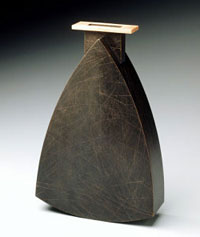MAD Museum Exhibits Elegant Armor: The Art of Jewelry
 Rocking Bottle, Susan Hamlet, 1987, Copper; fabricated, patinated
Rocking Bottle, Susan Hamlet, 1987, Copper; fabricated, patinatedPhotograph courtesy of MAD Museum
The exhibition Elegant Armor: The Art of Jewelry presents innovative pieces of contemporary metal art jewelry, dating from the 1940s to the present, at the MAD Museum in New York City. On view through July 5, the works on display range from the subtle to the flamboyant, from the purely geometric to the organic, and from narrative to sculptural works that extend the limits of the human body. The exhibition presents the major themes, materials and techniques that make contemporary jewelry visually exciting and intellectually stimulating.
Elegant Armor is divided into four major themes: Sculptural Forms, Narrative Jewelry, Painted and Textured Surfaces, and the Radical Edge.Important examples of sculptural jewelry by pioneers in the studio jewelry movement include Art Smith’s 1948 brass neckpiece and Margaret de Patta’s surprising kinetic brooch from 1947.
American jewelry artists are especially renowned for the narrative content in their wearable pieces that tell a story, convey messages through signs and symbols, take sociopolitical positions, or include imagery inspired by nature or the human body. Pioneering American jewelry artist Sam Kramer’s 1958 Roc Pendant draws on elements from the subconscious. Verena Sieber-Fuchs commented on apartheid by using paper for wrapping fruit in South Africa in her visually arresting 1988 Apart-heid collar.
The reaction against using precious metals to gauge the worth of jewelry is crystallized by Otto Künzli who hid a gold ball inside a rubber sleeve for his famous Gold Makes You Blind bracelet. The opposite of conspicuous consumption, this icon of twentieth-century jewelry uses symbols and ideas to outrank the value of tangible things.
Many works in the Museum collection reflect the impact of technology on our lives. Mary Ann Scherr, a leader in the American studio jewelry movement, investigated the potential relationship between jewelry and medicine in her 1974 Electronic Oxygen Belt while Ulrike Bahrs combined the fine materials of gold, silver, and garnets with holography to create a mysterious fleeting image in her brooch. American innovator Stanley Lechtzin created other-worldly jewelry without touching it by using computer-aided design and manufacture in his 1999 Plus-Minus brooch, while Daniella Kerner made her 1999 Mag-Brooch with selective laser sintering in DuraFrom polymide joined by rare earth magnets.
An illustrated, full-color book accompanies the exhibition containing an insightful essay by curator of jewelry Ursula Ilse-Neuman and dazzling new photography of approximately two hundred pieces from MAD’s jewelry collection.
Resources:
Also in this Issue:
- An Inside Look at Polich Tallix Fine Art Foundry
- Carol B. Saylor: In Her Mind's Eye
- Syed Ahmad: Capturing Fluid Movement in Glass on Copper
- Transcendence Through Copper
- MAD Museum Exhibits Elegant Armor: The Art of Jewelry
